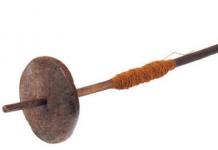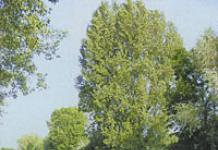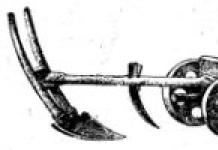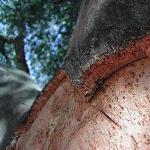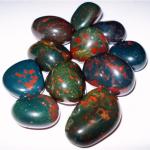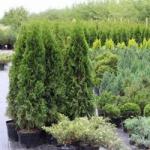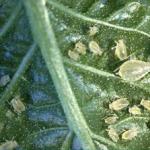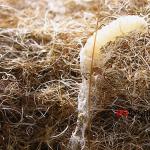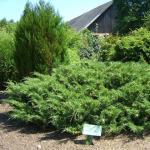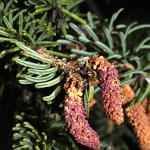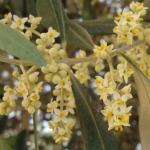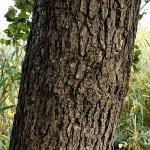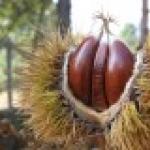In addition to flower crops, there has been a recent increase in interest and demand for evergreen and coniferous trees and shrubs. And this is understandable. Because they look the same all year round, support the composition of the garden or plot, which in itself is very profitable and attractive. In addition, these plants are very beautiful and harmoniously combined both in a group and one at a time.
- Back
- Forward
Grape
In gardens and home gardens, you can choose a warmer place for planting grapes, for example, on the sunny side of the house, garden pavilion, veranda. It is recommended to plant grapes along the border of the site. The vines formed in one line will not take up much space and at the same time will be well lit from all sides. Near buildings, grapes should be placed so that water flowing from the roofs does not fall on it. On level ground, it is necessary to make ridges with good drainage due to drainage furrows. Some gardeners, following the experience of their colleagues in the western regions of the country, dig deep planting holes and fill them with organic fertilizers and fertilized soil. Pits dug in waterproof clay are a kind of closed vessel that fills with water during the monsoon rains. In fertile land, the root system of grapes develops well at first, but as soon as waterlogging begins, it suffocates. Deep pits can play a positive role in soils where good natural drainage is provided, the subsoil is permeable, or reclamation artificial drainage is possible. planting grapes
You can quickly restore an obsolete grape bush by layering (“katavlak”). To this end, healthy vines of a neighboring bush are placed in grooves dug to the place where the dead bush used to grow, and sprinkled with earth. The top is brought to the surface, from which a new bush then grows. Lignified vines are laid on layering in spring, and green ones in July. They are not separated from the mother bush for two to three years. A frozen or very old bush can be restored by short pruning to healthy above-ground parts or pruning to the “black head” of an underground trunk. In the latter case, the underground trunk is freed from the ground and completely cut down. Not far from the surface, new shoots grow from dormant buds, due to which a new bush is formed. Grape bushes that have been neglected and severely damaged by frost are restored due to stronger fatty shoots formed in the lower part of the old wood and the removal of weakened sleeves. But before removing the sleeve, they form a replacement for it. Grape care
A gardener starting to grow grapes needs to study well the structure of the vine and the biology of this most interesting plant. Grapes belong to liana (climbing) plants, it needs support. But it can creep along the ground and take root, as is observed in Amur grapes in a wild state. The roots and the aerial part of the stem grow rapidly, branch strongly and reach large sizes. Under natural conditions, without human intervention, a branched grape bush grows with many vines of various orders, which comes into fruiting late and yields irregularly. In culture, the grapes are formed, give the bushes a form that is convenient for care, providing a high yield of high-quality clusters. Planting lemongrass
Chinese lemongrass, or schizandra, has several names - lemon tree, red grape, gomisha (Japanese), cochinta, kojianta (Nanai), kolchita (Ulchi), usimtya (Udege), uchampu (Oroch). In terms of structure, systemic relationship, center of origin and distribution, Schisandra chinensis has nothing to do with the real citrus plant lemon, but all its organs (roots, shoots, leaves, flowers, berries) exude the aroma of lemon, hence the name Schisandra. Lemongrass clinging or wrapping around a support, along with Amur grapes, three types of actinidia, is an original plant of the Far Eastern taiga. Its fruits, like real lemons, are too acidic for fresh consumption, but they have medicinal properties, a pleasant aroma, and this attracted a lot of attention to him. The taste of Schisandra chinensis berries improves somewhat after frost. Local hunters who consume such fruits claim that they relieve fatigue, invigorate the body and improve eyesight. In the consolidated Chinese pharmacopoeia, compiled back in 1596, it says: "Chinese lemongrass fruit has five tastes, classified in the first category of medicinal substances. The pulp of lemongrass is sour and sweet, the seeds are bitter-astringent, and in general the taste of the fruit is salty. Thus, It contains all five tastes. Grow lemongrass
 Evergreens are very popular in garden decoration. Gardeners get the opportunity to create an atmosphere of comfort on their site at any time of the year. Evergreen trees and shrubs create a pleasant partial shade in summer and serve as a backdrop for flowering plants. In late autumn they add variety to the dull gray landscape, and in winter they look very decorative against the backdrop of white snow.
Evergreens are very popular in garden decoration. Gardeners get the opportunity to create an atmosphere of comfort on their site at any time of the year. Evergreen trees and shrubs create a pleasant partial shade in summer and serve as a backdrop for flowering plants. In late autumn they add variety to the dull gray landscape, and in winter they look very decorative against the backdrop of white snow.
Types of evergreens
The range of evergreens is very diverse. There are not only well-known conifers, but also deciduous shrubs with powerful and beautiful flowering. Diverse in height, size, growth rate, evergreens are suitable not only for large areas. Low-growing and miniature varieties do not take up much space and are very popular with owners of small plots.
conifers
Once coniferous trees were used exclusively for planting on the streets of the city, but now they are often found in home gardens. Many gardeners have become true fans of these plants. The most common varieties of evergreen conifers:


In group plantings with the participation of conifers, it must be taken into account that their roots grow strongly and in the future these trees may occupy a rather large area.
Deciduous trees and shrubs
These plants come from tropical and subtropical countries, many of them are very thermophilic. Popular types of evergreen hardwoods:


It is necessary to plant evergreen hardwoods in places protected from strong winds.
In garden design
The choice of evergreens is great, this makes it possible to use them to decorate any garden landscape. Hedges and group compositions are formed with the participation of such plants:

The evergreen shrubs are the perfect backdrop for many flowering plants. In solitary plantings, such evergreen crops look good:
Evergreens improve the microclimate, save from monotony. They can become the main focus of the site or combined with other garden crops.







Evergreens, despite their assortment inferior to flowering crops, cannot be called boring. A variety of crops that do not lose their attractiveness both in summer and in winter can satisfy any taste. Along with the usual green crowns, original variegated and flowering plants can boast of winter-green foliage. And it’s impossible to remain indifferent to miniature shrubs and trees of dwarf varieties, as well as to the most bizarre-shaped beauties.
Juniper in the flower garden. © Solty & Sons
Irreplaceable talents of evergreen stars
Plants with winter green foliage are always perceived as special. They are beautiful in any season, at any time of the year. Stable attractiveness, immutability allow you to experiment with herbaceous plants and seasonal accents, as if “leaning” on an evergreen base. But the purely aesthetic characteristics of such cultures are always inferior to practical ones.
Evergreen accents are the most important skeletal crops. They are responsible for the attractiveness of the garden throughout the year, even in winter. Skeletal plantings are the foundation of landscaping, the base on which all decorative objects are based. When everything “temporary” - luxurious flowering, colorful leaf fall, incomparable parade of flyers - is over, the quality of the garden design can be judged by the main parameter: is there enough winter green crops in it so that it is not boring in the garden even in the coldest season .
Accordingly, with the main function, you need to use evergreens in the design of the garden. Considering them not as accents, but as a base, the basis of design, those invariable elements that will be present in landscaping for many years, “supports” for creating decorative groups, flower beds, discounts. Evergreens are placed both singly and in whole groups, combining with each other, used in hedges and groups of trees and shrubs. They perfectly combine with each other, combine, enhance the meaning and functions of each other. For example, you can easily mix holly and mahonia, cypress, rhododendrons, cherry laurel in a composition that will look luxurious in the active season, as if appealing to legendary southern motifs, and decorate gardens in winter.
 Japanese Pieris (Pieris japonica). © standhisround
Japanese Pieris (Pieris japonica). © standhisround On a note: the assessment of the garden according to the parameter of proper landscaping is carried out in winter, when all the main plants shed their leaves and even resistant perennials go into a dormant stage. Exposed crowns, empty flower beds should not make the garden boring. If it seems empty and lifeless to you, then you should introduce more evergreens into the design.
Regular doesn't mean boring
Evergreens, due to their stability, are often mistaken for the most boring category of garden plants. But winter-green beauties are able to surprise not only with a crown preserved for the winter, but also with an inimitable variety. The range of such plants is by no means limited to conifers, and among the latter there are non-standard varieties and inimitable originals. Plants with an unusual appearance for evergreen crops are by no means uncommon. Not only balls and figures made of yew and boxwood, hedges of laurel cherry and cypress, boring common spruces, holly, fir, junipers, pines and euonymus is limited to their range. In some you can observe unexpectedly powerful flowering, in others you can enjoy catchy needles or leaves, and still others will surprise you with their compact size and picturesque beauty of the “mini” format.
The range of evergreens allows everyone to find a suitable solution for almost any artistic task. Diversity concerns not only aesthetic qualities, but also height, size, growth rate. For small gardens, you can find excellent alternatives that, even at a considerable age, do not take up much space.
 Prickly goof (Elaeagnus pungens). © Bri Weldon
Prickly goof (Elaeagnus pungens). © Bri Weldon Let's get to know the most original and unusual of evergreen beauties closer
Wintergreen favorites with beautiful flowers or variegated leaves
The most beautiful and dark shades of green, as a rule, are characteristic of evergreens. But colors are not limited to luxurious greens at all, and in spring or summer you really want luxurious crowns to also join the general flowering parade. The problem with boring green will be solved by beautifully flowering species that hide under a lush cover of inflorescences for several weeks, as if exploding with bright flashes.
The most famous beautifully flowering evergreen shrub is the rhododendron. This is the most catchy, lush and elite garden shrub, preferring shading and predominantly acidic, nutritious soils. The only exception is the rhododendrons of the Inkarho group (inkarho-rhododendrons), which tolerate alkali well. Today, hardy hybrids are especially valued, and the choice is made not by species, but by varieties, the range of which covers a wide variety of shades and sizes.
 Beal Mahonia (Mahonia bealei). © songbirdPA
Beal Mahonia (Mahonia bealei). © songbirdPA  Mahonia medium (Mahonia media). © J.H.J.F.W. Br.
Mahonia medium (Mahonia media). © J.H.J.F.W. Br.  Holly barberry (Berberis aquifolium), or Holly mahonia (Mahonia aquifolium). © wallygrom
Holly barberry (Berberis aquifolium), or Holly mahonia (Mahonia aquifolium). © wallygrom  Photinia Fraser (Photinia fraseri). © Eva
Photinia Fraser (Photinia fraseri). © Eva  Photinia of David (Photinia davidiana). © Colin
Photinia of David (Photinia davidiana). © Colin  Kalina David (Viburnum davidii). © debbystagg
Kalina David (Viburnum davidii). © debbystagg But the range of evergreens from the flowering group is not limited to the most eminent shrubs. Also noteworthy:
- lovely evergreen Kalina David (Viburnum davidii) - one of the best decorative varieties of this classic shrub;
- Calmia broadleaf (Kalmia latifolia), known by the nickname of the mountain laurel, releasing numerous wide bells with a touching color in June;
- Japanese skimmia (Skimmia japonica), valued not only for spectacular umbrellas of inflorescences, but also for the beauty of red berries and in regions with harsh winters, combining garden and indoor "career";
- Wintergreen spiky or pointed (Gaultheria mucronata, we sometimes distribute under the old name Pernettya mucronata) - one of the most spectacular ornamental berry plants;
- hybrid Photinia Fraser (Photinia fraseri) with its white small flowers collected in panicles, formerly known as strandwesia (Stranvaesia) Photinia of David (Photinia davidiana);
- blooming in spring with yellow flashes mahonia(For example, Mahonia holly (Mahonia aquifolium), which is more properly called Barberry holly (Berberis aquifolium), hybrid Mahonia medium (Mahonia media), Mahonia Bila (Mahonia bealei) etc.
 Gaultheria spiky (Gaultheria mucronata). © Ross Bayton
Gaultheria spiky (Gaultheria mucronata). © Ross Bayton  Japanese skimmia (Skimmia japonica). © pittigliani2005
Japanese skimmia (Skimmia japonica). © pittigliani2005  Broad-leaved Kalmia (Kalmia latifolia). © JacoTen
Broad-leaved Kalmia (Kalmia latifolia). © JacoTen If flowering shrubs require more care, then variegated plants give the same effect of an explosion of colors, without burdening the seasonal work schedule at all. Almost any conifer has its own variegated varieties - from spruce to juniper, and other winter-green plants. For example, the variegated variety "Maculata" Loja prickly (Elaeagnus pungens) gives the entire bush an amazing elegance, a curly, lacy crown seems unusual and seems to glow from the inside.
Deserves much more recognition and a real chameleon - Pieris japanese (Pieris japonica) with colorful young shoots. Red twigs of the unique "Mountain Fire" variety or multi-colored, changing red to salmon, and then light green shoots of the "Forest Flame" variety, the variegated variety "Variegata" - there is plenty to choose from.
The best evergreens with an unusual shape of leaves or needles
Column-shaped spiers, pyramidal thujas or open junipers are unlikely to surprise anyone. But among the evergreens, there are also special forms, and exotic variants of needles or leaves. The status of winter green does not mean the absence of bizarre varieties and varieties.
 Sciadopitys whorled (Sciadopitys verticillata). © Powell Gardens
Sciadopitys whorled (Sciadopitys verticillata). © Powell Gardens  Japanese cryptomeria (Cryptomeria japonica). © Ross Bayton
Japanese cryptomeria (Cryptomeria japonica). © Ross Bayton  Small-flowered pine "Schoon's Bonsai" (Pinus parviflora). © von-hammel
Small-flowered pine "Schoon's Bonsai" (Pinus parviflora). © von-hammel One of the most original rarities in our gardens - Araucaria Chilean (Araucaria araucana). Its cone-shaped crown seems to be studded with triangular needles, and upon closer inspection, the bizarre structure of the needles seems more and more unusual. At a young age, araucaria are not very adapted to harsh winters, they need shelter, but the older they get, the better they tolerate the conditions of the middle zone.
More like outstretched wings, with feather branches, bizarre bushes of a unique yellow Yew berry (taxus baccata) - a rare variety " Dovastonii aurea". Combining an outlandish color with unusual drooping shoots, he seems alive and ready to move, looks great as an original accent. Drooping and sometimes hanging shoots, decorated with original needles, are also characteristic of the Blue Snake variety. Himalayan cedar (Cedrus deodara) and varieties "Pendula" Vicha firs (Abies veitchii).
It looks like tangled curls, gray, with a blue tint, the needles of a plant more familiar to us - Small-flowered pines (Pinus parviflora) varieties "Schoon's Bonsai". This is a very decorative and, moreover, medium-sized plant up to 2 m high, in which the crown always retains its density even at the bottom of the bushes.
 Vicha fir "Pendula" (Abies veitchii). © mvf
Vicha fir "Pendula" (Abies veitchii). © mvf  Yew berry "Dovastonii Aurea" (Taxus baccata). © Traumrune
Yew berry "Dovastonii Aurea" (Taxus baccata). © Traumrune  Chilean araucaria (Araucaria araucana). © Patrick Nicholas
Chilean araucaria (Araucaria araucana). © Patrick Nicholas Original needles - a distinctive feature Cryptomeria japonica (Cryptomeria japonica) varieties "Cristata". This is a large coniferous tree up to 10 m high, individual “needles” of which reach a length of 10-12 cm, are bent at the base and fancifully flattened on the sides, which makes them look like a cockscomb.
More like dill needles Sciadopitis whorled (Sciadopitys verticillata), often called Tuevik whorled, or Japanese umbrella fir. Capricious, tall, growing only on moist, super-nutritious and, moreover, acidic soil, the beauty, although it requires increased attention, turns into the main star of decoration.
Mini-accents that you cannot remain indifferent to all year round
Evergreens do not always have to be large in order to play their role in compositions. Yes, and in the design of places such as rock gardens, narrow ridges, ribbon flower beds, small front gardens, you do not use ordinary thuja or fir. Even for the most modest garden ensembles in terms of area, there are stars - dwarf varieties and types of familiar evergreen crops that seem especially spectacular. Shrubs and trees of the "mini" format attract attention with the perfection of forms, and the density of the crown, and catchy colors. They are the most luxurious of existing accents.
 Spruce blue "Conica" (Picea glauca). © F. D. Richards
Spruce blue "Conica" (Picea glauca). © F. D. Richards  Cherry laurel (Prunus laurocerasus). © English Hedging
Cherry laurel (Prunus laurocerasus). © English Hedging  Oriental flathead "Aurea Nana" (Platycladus orientalis) or Thuja orientalis (Thuja orientalis). © F. D. Richards
Oriental flathead "Aurea Nana" (Platycladus orientalis) or Thuja orientalis (Thuja orientalis). © F. D. Richards  Tupolis cypress "Nana Gracilis" (Chamaecyparis obtusa). © georgeweigel
Tupolis cypress "Nana Gracilis" (Chamaecyparis obtusa). © georgeweigel  Mountain pine, or European dwarf pine (Pinus mugo). © Jim Harding
Mountain pine, or European dwarf pine (Pinus mugo). © Jim Harding  Black pine "Nana" (Pinus nigra). © hgeers
Black pine "Nana" (Pinus nigra). © hgeers There are also mini-stars among flowering winter-green shrubs. Various varieties creeping rhododendron (Rhododendron repens), today attributed to the forms Rhododendron Forrest (Rhododendron forrestii), are practically invisible under the wonderful inflorescences. There is also a dwarf variety Laurel cherries officinalis (Prunus laurocerasus) - compact, 30-centimeter "Mount Vernon", in which the diameter of the bush is 2.5 times the height.
But still, the main stars among miniature evergreens are conifers. The best decorative mini-cultivars can be safely ranked as dwarf spruces, pines and Co.:
- A curvaceous beauty who will forever make you forget about boring ordinary spruce trees, a compact favorite - Spruce blue varieties "Conica" ( Picea glauca). Even in old age, this beauty will not exceed 3 meters in height, it will fit perfectly with its dense conical crown even in a flower bed of minimal size.
- Not exceeding 2-2.5 m slow growing Cypress obtuse (Chamaecyparis obtusa) varieties "Nana Gracilis".
- The most famous of the dwarf pines is the Pug variety. Pine mountain or European elfin pine (Pinus mugo), which grows so slowly that it takes decades to reach its maximum meter height.
- The main candidate for decorating flower beds black pine (Pinus nigra) varieties "Nana", limited to 3 meters and an amazingly compact crown.
- Dwarf favorite among thuja - variety "Aurea Nana" Tui eastern (Thuja orientalis, according to recent studies, it is more correct to call biota or Oriental flatworm (Platycladus orientalis), which is limited to a meter height. Needles resembling dense fur with a bright yellow color glow in sunny areas, conquer both texture and unusual density.
Having heard the words “evergreen tree”, the majority of the inhabitants of the middle lane will have before their eyes the depth and nobility of blue, silver, green firs, mighty cedars, slender pines. For a city dweller who has a country house with a garden, the list of trees that have a luxurious view both in winter and in summer is expanded by cypresses, arborvitae, and junipers.
Photo example:
In backyard gardens, planted in central Russia, beyond the Urals and in Siberia, evergreen trees are of particular importance: long snowy winters lack juicy summer greenery. And only evergreen conifers, sprinkled with snow, with their harsh noble appearance and deep green needles, remind of the summer holiday. 
There is an opinion that the literacy of garden landscaping should be assessed in winter: all deciduous trees crumbled, the snowy space is riddled with bare tree branches. If at this time the garden suddenly seems boring, uninteresting, then you should think about insufficient landscaping of the site and plan the planting of evergreens.

The Importance of Evergreen Bushes and Trees in Garden Design
Evergreen ornamental trees belong to the category of skeletal, supporting accents of the entire garden. Planted for many years, they form the basis, the basis of all garden design. Some flowers are forced out of the site by others, the gardener's preferences, as well as the layout of the site, may undergo some changes. Only perennial conifers grow into their place, setting the rhythm and determining the pattern of the entire garden in summer and winter.

A wide choice allows you to find a specimen for each specific task, because among evergreen trees there are miniature specimens, and weeping forms, and species with amazing shades of color.
The main advantages of conifers
The main advantages that determine a wide range of uses in the garden are the following qualities:
- Evergreen crops are unpretentious in care;
- Most of them prefer partial shade and shade;
- Perfectly combined with each other and decorative deciduous trees and shrubs;
- Perfectly tolerate forming and decorative pruning;
- They retain their decorative effect throughout the year, taking full responsibility for the aesthetics of the garden in winter.

The most popular conifers for landscape design
The idea of evergreen trees growing on the territory of Russia is associated precisely with conifers. The names of most of them are well-known, the appearance of even once exotic specimens is familiar.
Few people will be surprised by yew topiary, boxwood walls, cypresses cutting through the sky, blue spruces, creeping junipers. Conifers have long and firmly won the love of gardeners.
In addition to traditional tall conifers, compact, dwarf forms of conifers are increasingly being used in landscape design:
- Norway spruce "Tompa" - this green pyramid grows to a height of only one and a half meters, and the diameter at the base reaches two meters. Her photo:

- Dwarf form of balsam fir "Kiwi" - up to half a meter in height. Photo:

- Canadian spruce Picea glauca ‘Laurin’ by the age of ten, growing by 2 cm per year, reaches a height of 40 cm. Photo:

- Deciduous
Only a connoisseur can name evergreen deciduous trees that can grow in a harsh climate:
- The most famous and popular deciduous plant, existing in the form of a bush and small trees bearing a crown all year round, is boxwood. It is from its woody variety that huge complex figures and high dense fences are carved.

Culture can be called by other names: stone tree, buxus. Without a regular shaping haircut, it loses its decorative effect. Poisonous plant, requires hand protection when leaving.
- mahonia- frost-resistant, shade-loving plant, flowering and fruiting (magonia berries are used in the production of wine and confectionery).

In Russia, it is more common in the form of a dense evergreen shrub, from which dense hedges are obtained.

In winter, green leaves take on a reddish tint;

- laurel cherry- an evergreen tree, in its native places reaching a height of 6 meters, in a cold climate - up to two meters. Dense thickets of laurel cherry, so named because of the similarity with laurel foliage, and with cherries - fruits, form a dense hedge. It grows rapidly, has high decorative qualities. Despite the toxicity, it is used in folk medicine. Photo:

- Another tree, more reminiscent of a shrub in mid-latitude conditions, is euonymus.

Frost-resistant euonymus is very unpretentious with high decorative qualities. Prefers shade and partial shade in summer. Also applies to poisonous plants.

A garden created by painstaking work, supported by care and love, combining annual and perennial plants, deciduous and evergreen trees and shrubs, will be harmonious at any time of the year and will never get bored of its owner.
An evergreen ornamental shrub is a great option for landscape design next to a country house.
By planting an evergreen shrub for the garden, you get the opportunity to create a unique atmosphere of comfort in your home garden at any time of the year. They perfectly decorate the garden both in summer, creating a pleasant partial shade and a magnificent background for flowering plants, and in winter, against the backdrop of dazzling white snow.
ARUNDINARIA, BAMBOO — ARUNDINARIA
- Reproduction: dividing the bush in the fall, dividing the bush in the spring


Bamboos are becoming more and more popular. Many of them have an exotic appearance, but they are quite easy to grow. Provide some cover. In shiny arundinaria (A. nitida), 3 m high, the stems are purple. A. Muriel (A. murialiae) with yellow stems has a height of 3 m, and the giant magnificent Arundinaria (A. fastuosa) - 6 m.
Evergreen flowering plants allow you to solve two problems at once. If you plant an evergreen flowering shrub, you will get a great backdrop and beautiful blooms.
AUCUBA — AUCUBA
- Flowering time: September - January


Plants with large colorful leaves for a shady spot. It will grow anywhere, but icy winds can damage new growth. The fully green Japanese aucuba (A. japonica) grows to a height of 2m and has many varieties such as 'Longifolia' (narrow leaves) and 'Picturata' (leaves with a yellow center).
ARBUTUS - Strawberry tree, strawberry
- Location: sunny or partial shade


A slow-growing shrub that has hanging flowers and strawberry-like fruits on the plant at the end of autumn - these fruits are tasteless. The popular large-fruited strawberry (A. unedo) reaches a height of 2 m. Its flowers are white, and A. u. 'Rubra' has pinkish flowers.
BOXWOOD— BUXUS
- Location: sunny or partial shade


It withstands wind, alkaline soils and some shade. The stems can be cut regularly. Boxwood evergreen (B. sempervirens) - the main species it will grow to 3 m if left uncut. Its cultivar 'Aureovariegata' has yellow spotted leaves; "Suffruticosa" - dwarf.
Callistemon — CALLISTEMON
- Flowering time: June - July
- Reproduction: cuttings under glass in summer


Small flowers with prominent stamens are tightly collected in cylindrical inflorescences. Grow this plant near a sunny wall. Callistemon lemon yellow (C. citrinus) "Splendens" 2 m high has dark pink flowers and long leaves; Callistemon hard (C.rigidus) 1.5 m high is a more hardy species.
HEATHER — CALLUNA
- Location: best sunny
- Reproduction: cuttings under glass in summer


All heathers love poor soil and light, and cannot tolerate lime. Their leaves are often colored and they bloom in spring. Heather ordinary (C.vulgaris) 25-50 cm high is the only species, but there are many varieties with white, pink or lilac flowers.
CORDILINA — CORDYLINE
- Flowering time: June
- Location: sunny or partial shade


It is a palm-like plant. Grow it in a large pot or border in a mild climate. Cordilina southern (C. australis) 2 m high has pale green leaves from 30 cm to 1 m long. The Purpurea form has purple foliage. 'Torbay Dazzler' has white-striped leaves.
Evergreens for summer cottages and gardens and their photos
When choosing evergreens for the garden, consider their height and decorative properties. Properly selected evergreens for summer cottages help in improving the microclimate. Look at photos of evergreens for the garden and read their brief characteristics.
HOLLY, HOLY — ILEX
- Flowering time: October - December
- Location: sunny or partial shade
- Reproduction: lignified cuttings in autumn


Common holly (I.aquifolium) 3 m high is a symbol of Christmas, but there are varieties whose leaves differ from its pointed evergreen leaves. 'Golden King' has yellow-edged leaves, 'Argentea Marginata' has white-edged leaves. P. gorodchaty (I. crenata) "Golden Gem" foliage like boxwood.
LAVR— LAURUS
- Location: sunny or partial shade
- Reproduction: acquisition of new plants


This plant is grown in the herb garden. Or in a container, like a neatly trimmed shrub. The noble laurel (L. nobilis) has a height of 2.5 m. It needs a protected place - the leaves can be damaged by frost. Yellow flowers and black berries may appear on female specimens.
TRACHICARPUS — TRACHYCARPUS
- Flowering time: June
- Location: best sunny
- Reproduction: acquisition of new plants


Only one true palm can be considered hardy. It can withstand winter frosts in most areas, but needs protection from freezing winds. In Trachycarpus Fortune (T. fortunei), 3 m high, leaves up to 1 m wide are located in the upper part of the thick trunk. Large inflorescences of tiny flowers appear in summer.
ELM, ILM — ULMUS
- Reproduction: acquisition of new plants


Dutch elm disease has swept away countless popular elms such as Bare Elm (U. glabra) and High Elm (U. procera). Prefer a species that has been noted for its disease resistance. The small-leaved elm (U. parvifolia) is a good example. 'Geisha' is small and has white-edged leaves.
Evergreen shrubs: photos and names
The evergreen shrubs presented below in the photo with the names will help you navigate the huge assortment of these plants. A beautiful evergreen shrub may require additional care in central Russia. Therefore, all names and photos of evergreen shrubs are accompanied by brief descriptions of the characteristics. Look at the photo of evergreen shrubs and choose the type that suits your decorative properties.
CAMELLIA — CAMELLIA
- Flowering time: June - July
- Reproduction: acquisition of new plants


An unusual shrub that needs protection from the south or west wall. Some shoots may freeze in winter. Camellia Californian (C. californica) 2 m high has white flowers with a center of golden stamens. Leaves below with white felt pubescence. Variety "Ladham's Variety" with more abundant flowering.
CAMELLIA — CAMELLIA (Variety C.japonica "Adolphe Audusson")
- Flowering time: depends on the species
- Location: sunny or slightly shady
- Reproduction: cuttings under glass in summer


Spectacular flowers with a diameter of 5 to 15 cm, simple or double, white, pink or red. Non-alkaline soil is needed, as well as protection from cold winds. There are two species - Japanese Camellia (C. japonica) 2 m high, blooming in February-April, and Camellia Williams (C. williamsii) 2 m high with flowers in February-May.
CISTUS, CISTUS — CISTUS
- Flowering time: June - August
- Location: definitely sunny
- Reproduction: cuttings under glass in summer


Short-lived flowers, often spotted at the base. The buds appear regularly and the shrub blooms constantly throughout the summer. There are low varieties, reaching a size of less than 1 m, such as 'Silver Pink' and white Cistus corbariensis (C. corbariensis). An example of a high species is Cistus purple (C. purpureus).
Choisia — CHOISYA
- Flowering time: April - May
- Location: sunny or slightly shady
- Reproduction: cuttings under glass in summer


This neat rounded shrub has a year-round densely leafy crown. Flat inflorescences of wax flowers appear in spring - both leaves and flowers are fragrant. View for the garden - Choisia trifoliate (C. ternata) 2 m high. The Sundance variety has yellow foliage, the Aztec Pearl variety has narrow leaves.
Bindweed— CONVOLVULUS
- Flowering time: May - August
- Location: definitely sunny
- Reproduction: cuttings under glass in summer


Attractive but rather tender shrub that provides year-round interest. The leaves are silvery gray and the white flowers appear throughout the summer. Shrub bindweed (C. cneorum) has a height of 50 cm and pink buds that open into funnel-shaped flowers. Frost can damage foliage.
DEFONTENIA — DESFONTAINIA
- Reproduction: cuttings under glass in summer


This shrub requires a mild microclimate location, partly shaded, near a wall. Defontenia prickly (D. spinosa) 50 cm high has red flowers with yellow edges. Buy large specimens if you need to fill a space - they grow very slowly over about 10 years.
ERIKA — ERICA
- Flowering time: depends on the species
- Location: best sunny
- Reproduction: cuttings under glass in summer


More versatile than heather (page 118). There are cultivars for flowering in any month, and colors ranging from white to almost black. There are species that are tolerant of lime, such as Erica ruddy (E. carnea) 20 cm tall, blooming in early spring, and not tolerant of lime, such as Erica ash (E. cinerea) 25 cm tall, blooming from July to September.
Escallonia — ESCALLONIA
- Flowering time: June - September
- Location: sunny or partial shade


Small bell-shaped flowers cover the bush in summer. It grows vertically at first, then the stems are arched. Popular variety "Apple Blossom" 1.5 m high, slow growing; 'Donard Seedling' has pink flowers and is hardier; Escallonia red (E. rubra) "Macrantha" is more vigorous.
EVERSKLET— EUONYMUS
- Location: sunny or partial shade
- Reproduction: lignified cuttings in autumn


Evergreen species of euonymus are more popular than deciduous ones. Variegated-leaved varieties provide color in winter, and there are bushy forms for hedges. Forchun's euonymus (E. fortunei) 1 m high - ground cover species; Japanese spindle tree (E. japonicus) is a taller species for hedges.
FATSIA, ARALIA — FATSIA
- Flowering time: October - November
- Location: best part shade
- Reproduction: cuttings under glass in summer


Plant with large decorative leaves for shady places. Fatsia Japanese (F. japonica) 3 m high blooms in autumn with small cream flowers in spherical inflorescences, which are then replaced by black berries. Variety "Variegata" with white-edged leaves is less cold-resistant than the species.
More names of evergreens and their photos
Evergreens, which are presented later on this page, are not common. Below we invite you to find out the names of evergreens and appreciate their beauty in the photo.
HARRIA — GARRYA
- Location: sunny or partial shade
- Reproduction: cuttings under glass in summer


This shrub, 3 m high, is grown against the walls for its winter decoration - long and graceful inflorescences-earrings hang from the branches. Harry has elliptical (G. elliptica) earrings 20 cm long, at first having a gray-green color. The 'James Roof' variety has thicker earrings and is almost twice as long.
HEBE— HEBE
- Location: best sunny
- Reproduction: cuttings under glass in summer


The “whip-shaped” hebes have scaly leaves, for example, those of Armstrong's Hebe (H. armstrongii) are 1 m high. Low-growing hebes are less than 50 cm, for example, "Carl Teschner". Tall hebes - above 50 cm, for example, the Great Orme variety. Winter hardiness decreases with increasing leaf size.
HELIANTHEMUM, SUNFLOWER — HELIANTHEMUM
- Flowering time: May - July
- Location: definitely sunny
- Reproduction: cuttings under glass in summer


The flowers of this stunted shrub form a colorful canopy for many weeks in the summer, but each flower lives only a day or two. Annual pruning is important. Pelianthemums of the Wisley series are 20 cm high and have silvery gray leaves; Ben varieties such as 'Ben Hope' are neat and hardy.
St. John's wort —HYPERICUM
- Location: sunny or partial shade
- Reproduction: cuttings under glass in summer


St. John's wort, (H. calycinum) 50 cm high, having flowers with numerous fluffy stamens in the center. The variety 'Hidcote' has larger flowers. St. John's wort (H. moserianum) 'Tricolor' has variegated green-creamy-pink leaves. St. John's wort (H. inodorum) "Elstead" is decorative with red berries.
LEPTOSPERMUM — LEPTOSPERMUM
- Flowering time: May - June
- Location: best sunny
- Reproduction: cuttings under glass in summer


The flowers live for a long time and cover the entire foliage, if the necessary conditions are present. It needs a mild climate or shelter near a south wall and well-drained soil. Leptospermum broom-shaped (L. scoparium) 2.5 m high has white flowers; usually choose varieties with colored flowers, such as "Kiwi".
LAVENDER — LAVANDULA
- Location: best sunny
- Reproduction: cuttings under glass in summer


Low-growing bushes for a border or for dwarf hedges. L. narrow-leaved (L. angustifolia) is the most common. Its flowers are pale blue; 'Hidcote' has purple flowers. French lavender (L. stoechas) also with purple flowers. View with green foliage and white flowers - green lavender (L. viridis).
HATMA, LAVATERA — LAVATERA
- Flowering time: June - October
- Location: best sunny
- Reproduction: acquisition of new plants


Fast growing shrub that blooms all summer with large flowers. It is easy to grow, but needs to be severely pruned every year. Khatma "Rosea" 2 m tall blooms with pink flowers; "Barnsley" - pink and white with a red eye. Khatma seaside (L. maritima) is not quite hardy.
PRIVET — LIGUSTRUM
- Flowering time: depends on the species
- Location: sunny or partial shade
- Reproduction: lignified cuttings in autumn


Common privet (L. vulgare) has evenly colored green foliage, but there are also varieties with colored leaves. Privet oval-leaved (L. ovalifolium) "Aureum" 2 m high has yellow leaves with a green center; "Argenteum" with yellow edges. Several species bloom in summer.
LUPINE —LUPINUS
- Flowering time: June - August
- Location: definitely sunny
- Reproduction: sowing seeds in autumn


Wood lupine is rare, unlike its grassy border relatives. It has a short lifespan, and its inflorescences are shorter than hardy perennial hybrids. Tree lupine (L. arboreus) 1.5 m tall has yellow fragrant flowers and grayish-green leaves; grade "Mauve Queen" purple. Not for heavy soils.
MAGONIA— MAHONIA
- Flowering time: depends on the species
- Location: best part shade
- Reproduction: cuttings under glass in summer


Tolerates any soil and shade. Fragrant spring flowers give way to purple or black berries. In Holly Magonia (M. aquifolium), 1 m high, the flowers are located in compact inflorescences; Magonia Japanese (M. japonica) 2 m tall with long inflorescences diverging like rays.
OLEARIA — OLEARIA
- Flowering time: depends on the species
- Location: best sunny
- Reproduction: cuttings under glass in summer


The shrub is covered in daisy-like blooms in summer, but will look scrawny when not in bloom unless pruned annually. Olearia large-toothed (O. macrodonta) 2.5 m tall blooms in June and has leaves like a holly. Olearia Haast (O. haastii) has leaves like boxwood. Olearia Scillonian (O. scilloniensis) 1.5 m high blooms in May.
MYRTLE — MYRTUS
- Flowering time: July - September
- Location: best sunny
- Reproduction: cuttings under glass in summer


Myrtle is not popular. The problem is that it is damaged as a result of severe frost and icy wind. Common myrtle (M. communis), 3 m high, is the main species. Small white flowers with fluffy stamens in the center. Variety 'Variegata' has cream-colored leaf margins.
OSMANTHUS — OSMANTHUS
- Flowering time: depends on the species
- Location: sunny or slightly shady
- Reproduction: cuttings under glass in summer


Neat bushes are covered with evergreen leaves - the flowers have the scent of jasmine. Osmanthus Delave (O. delavayi) 1 m high - the most popular species with tubular flowers in April - May. Osmanthus Berkwood (O. burkwoodii) is more vigorous. Osmanthus variegated (O.heterophyllus) "Variegata" blooms in September, leaves like a holly.
NANDINA — NANDINA
- Flowering time: June - October
- Location: best sunny
- Reproduction: dividing the bush in the fall


Color changes throughout the year. Foliage is red in spring and leaves turn purple in autumn. Nandina home (N. domestica) 1 m high is the main species. It blooms with white star-shaped flowers in conical inflorescences, and berries appear later. The "Firepower" variety is even more colorful.
PACHISANDRA — PACHYSANDRA
- Flowering time: March
- Location: best shady
- Reproduction: dividing the bush in spring


Pachysandra is a ground cover plant that can grow under a branched plant. The densely spaced leathery leaves inhibit the growth of weeds. Pakhisandra apical (P. terminalis) 20 cm tall - a common species with white inconspicuous flowers. The Green Carpet variety is more compact.
PERNETTIA — PERNETTYA
- Flowering time: November - February
- Location: sunny or partial shade
- Reproduction: rooted offspring in autumn


The mass of flowers in early summer is replaced by large berries on the female plants of this undersized thorny shrub. These fruits are not touched by birds. Pernettia pointed (P. mucronata) - a garden view 75 cm high; 'Cherry Ripe' has red berries. Variety "Mascula" male, "Bell's Seedling" monoecious.
ZOPNIK — PHLOMIS
- Flowering time: June - July
- Location: best sunny
- Reproduction: cuttings under glass in summer


Plants become unattractive with age - heavy pruning is needed each year to ensure new stems are formed. Shrub thorn (P. fruticosa) 1 m high bears whorls of yellow flowers 5 cm wide. Golden-leaved thorn (P. chrysophylla) is similar to it, but the leaves turn yellow in autumn.
FIGELIUS — PHYGELIUS
- Flowering time: July - October
- Location: sunny or slightly shady
- Reproduction: cuttings under glass in summer


In the spring, cut off all the stems or simply cut off the frost-affected lateral shoots. Figelius Cape (P. capensis) 2.5 m high has red flowers with a yellow throat, located around the axis of the inflorescence; Figelius equal (P. aequalis) "Yellow Trumpet" is smaller and has one-sided inflorescences.
Other evergreen shrubs and plants
Don't dwell on what you have already learned. See below for other evergreen shrubs and plants.
PHOTINYA — PHOTINIA
- Flowering time: April
- Location: best sunny
- Reproduction: cuttings under glass in summer


Photinia Fraser (P. fraseri) "Red Robin" 2.5 m high. Its young foliage is bright red in spring; if you cut off the tops of the shoots, new red leaves will appear again. Inflorescences of small flowers appear after a mild winter. Needs a protected place. 'Robusta' is similar in appearance, but the new growth is copper in color.
PIERIS — PIERIS
- Flowering time: March - May
- Location: Best slightly shady
- Reproduction: acquisition of new plants


In spring, long inflorescences of small flowers appear, and the most popular varieties have decorative bright red young leaves. Pieris beautiful Forrest (P formosa forrestii) 3 m high has white flowers and red young leaves. P Japanese (P japonica) is a more compact species.
PITTOSPORUM— PITTOSPORUM
- Flowering time: May
- Location: sunny or slightly shady
- Reproduction: cuttings under glass in summer


Black branches and leaves with wavy edges are used by florists, but there are also beautiful flowering species. Fully or partially bushes may die in harsh winters. Pittosporum thin-leaved (P tenuifolium) 3 m high is quite hardy. Pittosporum tobira (P tobira) is the best flowering species, but too tender.
PLUM, LAUREL CHERRY — PRUNUS
- Flowering time: depends on the species
- Location: sunny or partial shade
- Reproduction: cuttings under glass in summer


Evergreen species of the genus Prunus are popular for hedges. Trim your hedge in late summer. Laurel cherry medicinal (P. laurocerasus) 5 m high blooms in spring with white flowers. Plum Lusitanian (P.lusitanica) 2.5 m high has leaves with red petioles and blooms in early summer.
RHODODENDRON – RHODODENDRON
- Flowering time: depends on the variety
- Location: best part shade
- Reproduction: acquisition of new plants


The average height of rhododendrons is about 1.5 meters and they bloom in May, but there are many varieties - a height range of 30 cm to 6 m and a range of flowering times. There are hardy hybrids, dwarf hybrids and species (eg R. arboreum).
PYRAKANTA— PYRACANTHA
- Flowering time: October-January
- Location: sunny or partial shade
- Reproduction: cuttings under glass in summer


This is a hardy shrub. At the end of spring it blooms with white flowers, which are then replaced by berries. The leaves are toothed and the stems are spiny. Pyracantha bright red (P. coccinea) "Lalandei" has orange-red berries; "Teton" - yellow. Pyracantha atalantoid (P. atalantioides) grows vertically.
RHODODENDRON, AZALEA — RHODODENDRON
- Flowering time: April - May
- Location: best part shade
- Reproduction: acquisition of new plants


Usually, azaleas are graceful plants with smaller leaves than rhododendrons, but not always. Evergreen groups are described here. They are stunted, reaching a height of 60 cm - 1.5 m, and there are several groups such as Vuyk hybrids, Kaempferi and small-flowered Kurume hybrids.
ROSEMARY —ROSMARIUS
- Flowering time: April - May
- Location: best sunny
- Reproduction: cuttings under glass in summer


A good plant for growing in a border. The vertically growing stems are densely covered with narrow leaves, and small flowers appear on the stems in spring. Rosemary officinalis (R. officinalis) 1.5 m high has gray-green leaves and lavender flowers; 'Albus' flowers are white
RASPBERRIES — RUBUS
- Flowering time: June - August
- Location: sunny or partial shade
- Reproduction: cuttings under glass in summer


These are shrubs with thorny stems, or tall vines. The flowers of most species are similar to non-double roses. Raspberry tricolor (R.tricolor) 60 cm high has white flowers and red fruits; Raspberry elmifolius (R. ulmifolius) "Bellidiflorus" blooms with double pink flowers. Raspberry Henry (R. henryi) - vine 6 m high.
SANTOLINA — SANTOLINA
- Flowering time: June - August
- Location: definitely sunny
- Reproduction: cuttings under glass in summer


Low-growing shrubs with silvery leaves and yellow, button-like flowers. Santolina cypress (S. chamaecyparissus) 60 cm high is the main species - flower buds are sometimes removed to improve the decorative foliage. Variety "Nana" is used for edging.
SARCOCOCCA— SARCOCOCCA
- Flowering time: January - February
- Location: sunny or shady
- Reproduction: cuttings under glass in summer


A plant much loved by flower arrangers. Sarcococcus confused (S. confusa) 75 cm high has oval leaves and black berries; Sarcoccus Hooker (S. hookeriana) "Digyna" 1.5 m high has narrow leaves with a purple tint. Variety "Humilis" - dwarf, 30 cm high, and is used as a ground cover plant.
SKIMMIA — SKIMMIA
- Flowering time: March - April
- Location: sunny or partial shade
- Reproduction: cuttings under glass in summer


She has shiny leaves all year round, and in spring inflorescences of small flowers appear, which are replaced by berries by autumn. Japanese skimmia (S. japonica) 1 m high. You will need a female variety, such as 'Veitchii', and a male one, like 'Fragrans', in order for the berries to appear. Variety "Robert Fortune" monoecious.
YUCCA — YUCCA
- Flowering time: July - August
- Location: best sunny
- Reproduction: rooted shoots in autumn


Despite its exotic appearance - xiphoid leaves and large inflorescences - it is quite hardy. Yucca filamentous (Y filamentosa) has stiff leaves 60 cm long with white fibers along the edges. Flowering stems are 1.5 m high. Yucca drooping (Y. flaccida) has less hard leaves, while glorious Yucca (Y gloriosa) leaves are very pointed.
